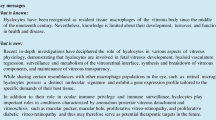Abstract
· Background: Corneal endothelial cell transplantation has been an intriguing concept as an alternative to full-thickness penetrating keratoplasty. Using a murine corneal transplantation model, we sought to establish the optimal conditions to repopulate, ex vivo, denuded murine Descemet’s membrane with life-extended cell cultures of murine corneal endothelial cells. These ex vivo repopulated corneas were used as donor corneas in a murine orthotopic corneal transplantation model to assess, in vivo, the function of the transplanted, life- extended murine corneal endothelial cells (MCEC). · Methods: Mouse corneas were surgically trephined and the native corneal endothelium was removed mechanically using a sterile cotton swab. Cultured murine corneal endothelial cells (life extended by expression of the SV40 large T antigen) were added onto the denuded Descemet’s membrane and allowed to attach in culture at 37°C. Evidence of corneal cell attachment to Descemet’s membrane was determined between 1 and 8 h by scanning and transmission electron microscopy. Donor life-extended corneal endothelial cells were labeled with a fluorescent dye to allow tracking of the donor cells following seeding onto denuded Descemet’s membrane. In four independent experiments, the Descemet’s repopulated corneas were placed into syngeneic mice and evaluated for corneal clarity after 6 weeks. · Results: We could detect attachment of the life-extended murine CEC by scanning and transmission electron microscopy to denuded Descemet’s membrane. The optimal time for adherence was 2 h and these repopulated corneas were used as donors in a murine model of penetrating keratoplasty. Of 20 mice evaluated after 6 weeks, 4 displayed corneal clarity, and fluorescent evaluation demonstrated that only the donor corneal endothelial cells were present. · Conclusions: This experimental protocol establishes that ”life- extended” MCEC can bind to Descemet’s membrane ex vivo and form a distinct monolayer. The repopulated Descemet’s membrane allowed us to directly test the hypothesis that cultured life-extended corneal endothelial cells are functional when reintroduced into an in vivo milieu and provides evidence that specific corneal endothelial cell transplantation may be a viable alternative to pentrating keratoplasty.
Similar content being viewed by others
Author information
Authors and Affiliations
Additional information
Received: 21 July 1999 Accepted: 22 September 1999
Rights and permissions
About this article
Cite this article
Joo, CK., Green, W., Pepose, J. et al. Repopulation of denuded murine Descemet’s membrane with life-extended murine corneal endothelial cells as a model for corneal cell transplantation. Graefe's Arch Clin Exp Ophthalmol 238, 174–180 (2000). https://doi.org/10.1007/s004170050029
Issue Date:
DOI: https://doi.org/10.1007/s004170050029




